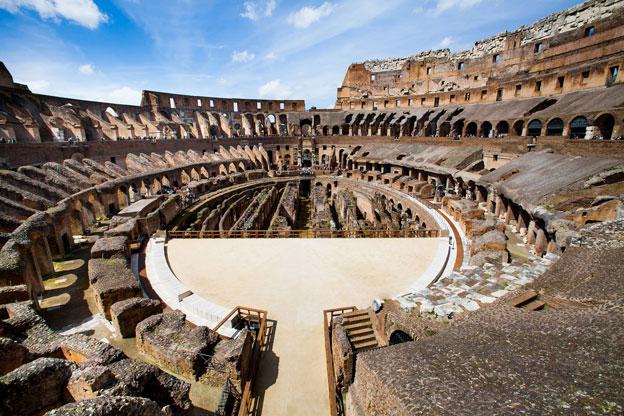On a recent visit to Rome, I had the pleasure to explore secret spots inside the Colosseum visitors don’t usually have access to, while learning many fascinating tidbits of Colosseum history. I was on a small group tour led by the very knowledgeable guide Agostina Appetecchia, an archeologist, of the Rome-based The Roman Guy tour company.
The Roman Guy runs a tour of the Colosseum that includes the combat ground, the dungeons, and the third level. These are all restricted areas which you don’t have access to with a regular ticket.
As we entered the Colosseum skipping the usual long lines, we followed our guide Agostina, or Nina as she likes to be called, to the reconstructed combat ground, or arena, from the Latin word for sand. The combat ground was covered with it because sand helps absorb blood - and a lot of blood was spilled inside the Colosseum.
At the center of the combat ground, looking up toward the bleachers, as puzzled tourists looked down at us probably wondering who we were – VIPs or modern-day gladiators? – and as Nina talked history, I started imagining what it must have been like for gladiators to stand there, after emerging from the darkness of the dungeons, with tens of thousands of bloodthirsty spectators – between 50,000 and 70,000 - cheering on them.

Gladiators, Nina explained, were revered like the football stars or Hollywood celebrities of the present day. They were examples of courage, bravery and discipline. Contrary to popular belief, and this may be disappointing to some, they were not all necessarily tall and muscled and handsome, as Nina’s favorite gladiator...Russell Crowe (remember the movie "Gladiator"?!). Rather, they were often quite short and plump, a bit stocky; the excess fat was useful protection from wounds. Contrary to what they show you in movies in fact, gladiators fought with their bare chests, not with an armor. Yet, even if not always good-looking, they were favorites of the ladies; more than one noble Roman woman are said to have run away with a gladiator.
Gladiators’ combats were the most important and anticipated show of the day, but they didn’t begin until the afternoon. The Colosseum spectacles were an all-day affair, starting in the morning with the venationes, the “hunts” between men and animals. During the lunch break, spectators were entertained with public executions of criminals, and it was after those two “shows” that the "real fun" began with the gladiators combats, or munera. A day at the Colosseum was full of violence, yet games at the Colosseum were considered a family show. Not only that, the Colosseum was a central component of social life in Rome.

It was emperor Vespasian who decided to build the Colosseum, in 72 AD, within the Domus Aurea, the imperial residence built by Nero in the center of the city. After Nero died, Vespasian wanted to give back this area to the Romans and had a brilliant idea: drain the lake that was part of the imperial residence and use the empty bed to put down the foundations of the Colosseum, which was to become the largest amphitheater ever built dedicated to the people of Rome. The original name of the Colosseum is actually Anfiteatro Flavio (Flavian Amphitheater), from the Flavian dynasty to which Vespasian and his successor Titus, who completed construction, belonged. The name Colosseum derives from the huge, 41-meter high statue of Nero, which used to be placed to the side of it and was known as Colosso (meaning giant, behemoth).
It took only 8 years to build the Colosseum: 100,000 cubic meters of travertine were used to create a massive structure of four floors, 50 meters high – and after 2,000 years, it is still standing. It makes you realize how skilled the architects and engineers of the time were. (If you've ever wondered about the part that’s missing, it crumbled down during an earthquake in the Middle Ages.)

Reluctantly (we wanted to hear more stories about the gladiators!), we left the arena and started descending to the dungeons' area, which at the time was known as “hell”, because it was dark, humid and fetid: two underground floors with corridors and stairs, rooms, cages with animals, and jail cells housing criminals to be executed. A corridor connected the area where the gladiators lived and trained. The dungeon had the same function of a theater's backstage, but instead of being located to the sides of the stage, it was underground. A special fork lift allowed the animals and gladiators to be lifted up to the combat ground.
After the visit to the dungeon was completed, we went from bottom to top: climbing up, we reached the third level. The view from there is oustanding. Looking to the outside, you can see the Via dei Fori Imperiali and the Roman Forum and you get an idea of the extent of that area. Looking to the inside, you can see all of the Colosseum. Of course, what you see today is very different from what the Colosseum looked like, beginning from the color, which was an ivory white; bleachers are no longer there, replaced by ribs of brown/grayish bricks.

And yet, you still get a thrill thinking about all that happened inside. Roughly four million people flock to the Colosseum every year; 2,000 years on, the cruel fascination of this place remains intact, perhaps because there is no other place, in the world and in history, like the Colosseum.
To book your tour of the Colosseum with Dungeons, 3rd Level and Arena Stage, click here.
The Roman Guy offers many small group tours in Rome, including a "Privileged Entrance" Vatican & Sistine Chapel Tour" (enter before the crowds arrive!) and a really fun "Eco Rome Golf Cart Tour". For more information about the tours on offer, check The Roman Guy's website.











